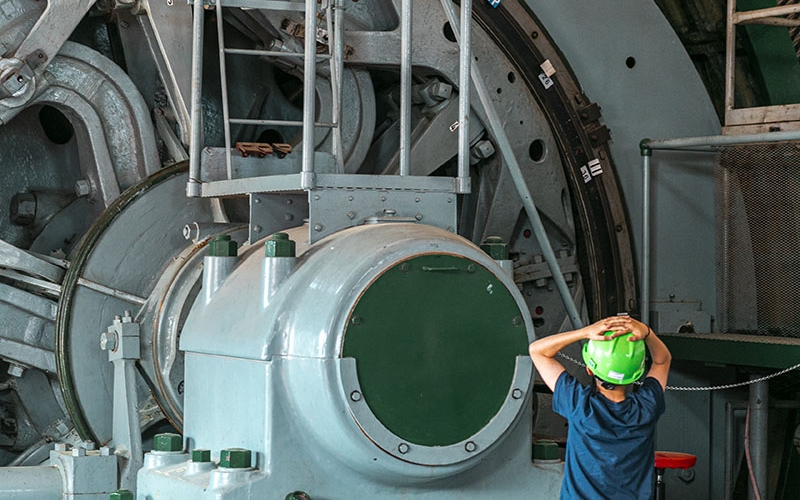Winston
Lorenzo von Matterhorn
- Joined
- Jan 31, 2009
- Messages
- 9,560
- Reaction score
- 1,748
Why the U.S. Is Betting It All on the Most Puzzling Particle in the Universe
19 May 2020
https://gizmodo.com/why-the-u-s-is-betting-it-all-on-the-most-puzzling-par-1843517654
Nearly 14 billion years ago, a universe appeared in an unthinkably high-energy blast. Particles started to materialize out of that energy, as did their antiparticles, which are kind of like evil twins, a mirror image with the opposite electric charge. Each and every particle had an antiparticle, scientists believe, and they would annihilate each other in a pop of energy. Most particles met their end at the hands of their antiparticle in those earliest days.
Most particles met their end, I said—but not all. A small amount of matter persisted over the antimatter, and it condensed into galaxies, stars, planets, and eventually people. Some of those people wondered: What could possibly have been different between the matter and antimatter such that the matter dominated? Or, in short: Why are we here?
Today, many physicists think they’ve identified a signpost guiding them toward that question’s answer, thanks to the strange behavior of the universe’s most abundant matter particle, the neutrino, sometimes called a “ghost particle.” The difficult-to-detect neutrino seems to undergo a strange identity-flipping process, and if this reaction occurs differently between neutrinos and antineutrinos, then this process, called neutrino oscillation, could help physicists explain why matter dominates over antimatter. Unlike the last few decades of successful particle hunts, neutrino physics is a trek into the unknown, one that the United States physics community has chosen to pursue full-on. A flagship, $2 billion experiment called LBNF/DUNE will lead the search, in pursuit of answers that may take decades or more to find.
“I think we’re seeing a real change here in what particle physics is about,” Joe Lykken, Fermilab’s deputy director of research, told Gizmodo. “For a long time, it was about producing new particles, which people won Nobel prizes for. That was fine, but at the end of the day, our job as scientists is to understand the basic processes of the universe and how it works… It’s not about adding more particles to a long list of particles; it’s about, how does the universe really operate in a fundamental way to produce what we see today?”
[snip]
Standing on the platform overlooking ProtoDUNE with CERN physicist Stefania Bordoni, I realized that these enormous cubes were just a fraction of the final DUNE far detector, the larger of the experiment’s two detectors. They were prototypes to ensure that the production equipment would work and to test two different kinds of detecting technologies. The DUNE far detector will ultimately dwarf ProtoDUNE, with its 68,000 tons of liquid argon in four units built 4,850 feet underground in the Sanford Underground Research Facility, located at the retired Homestake precious metal mine in Lead, South Dakota.
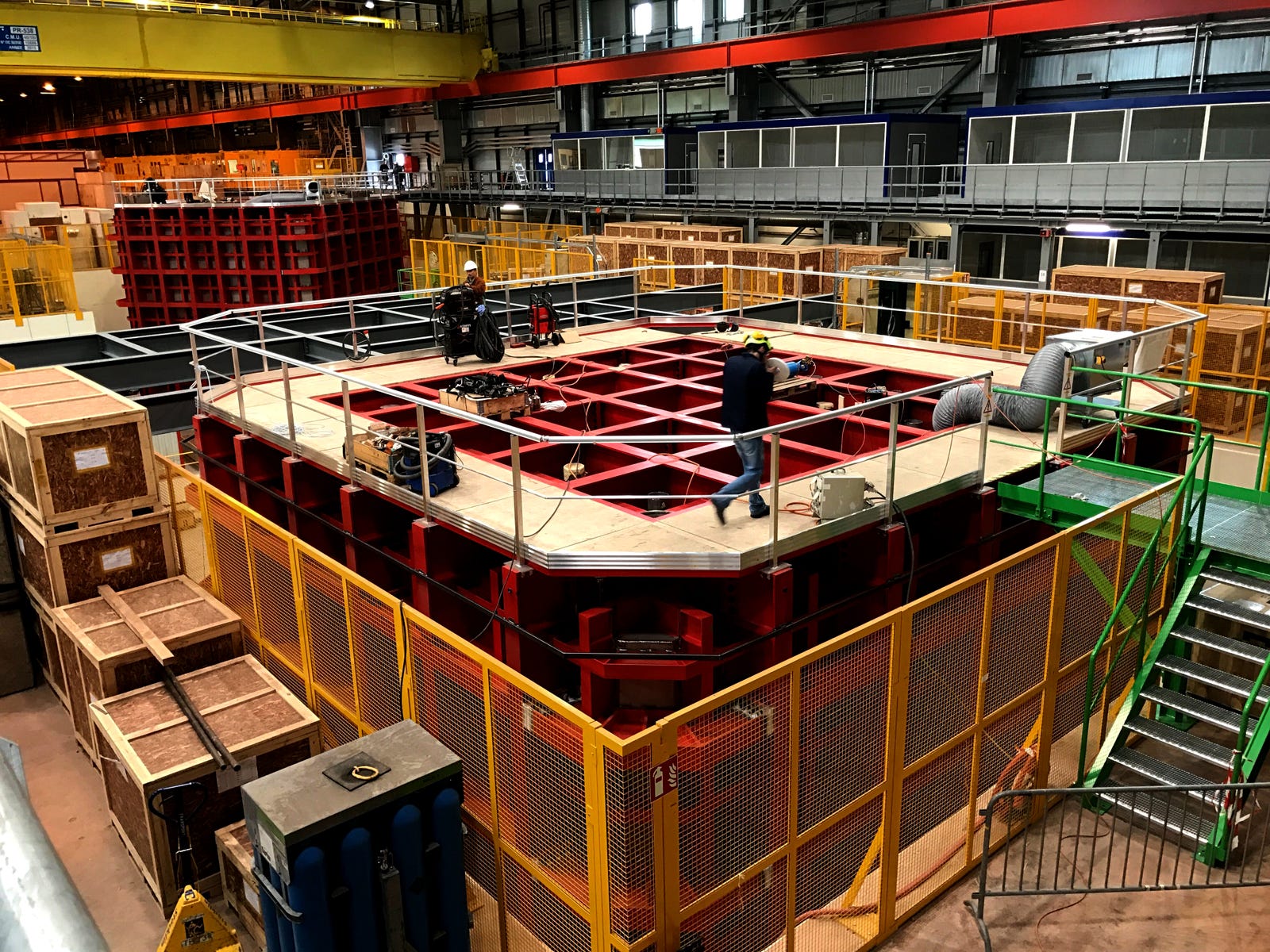
ProtoDune interior:
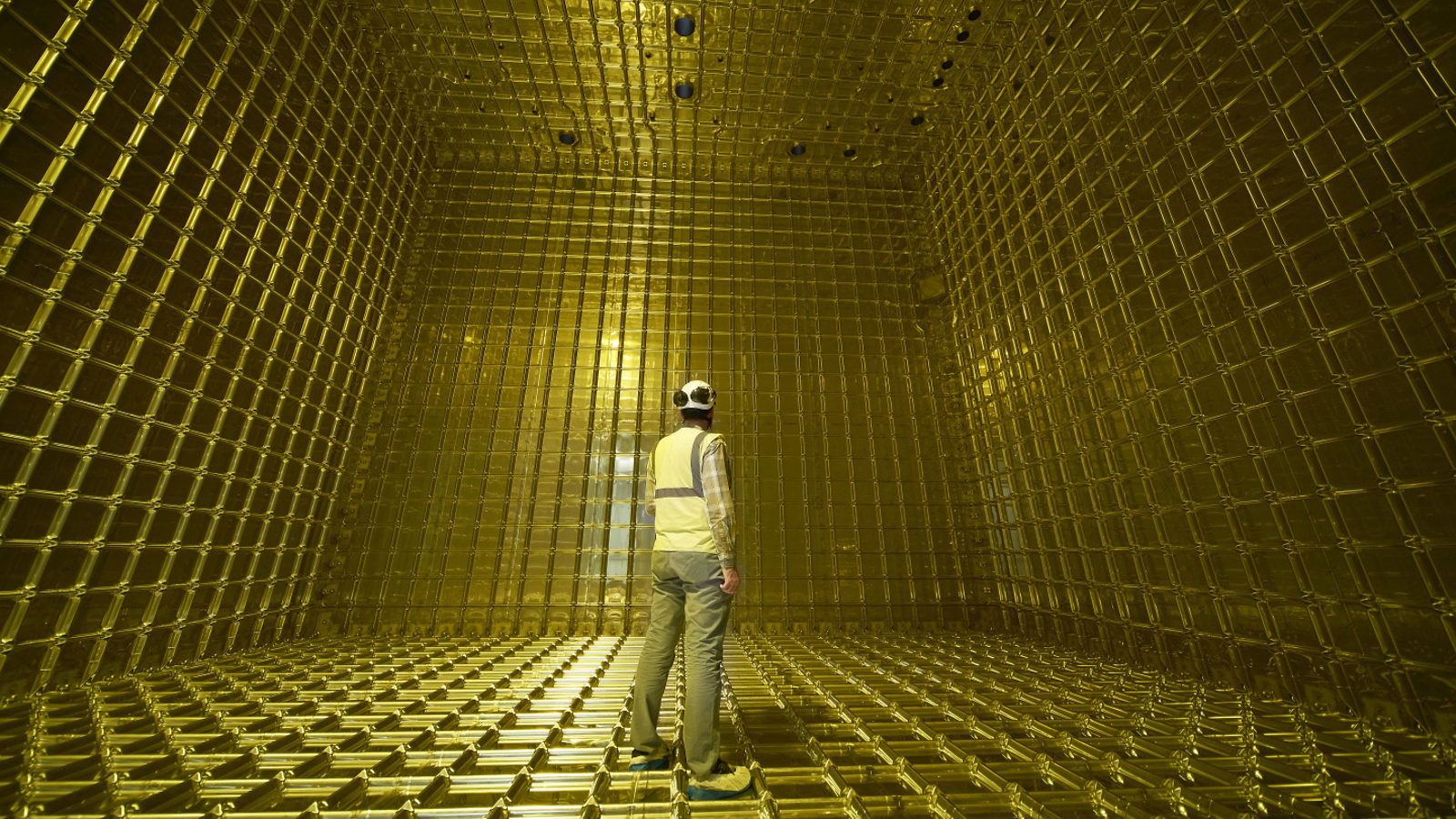
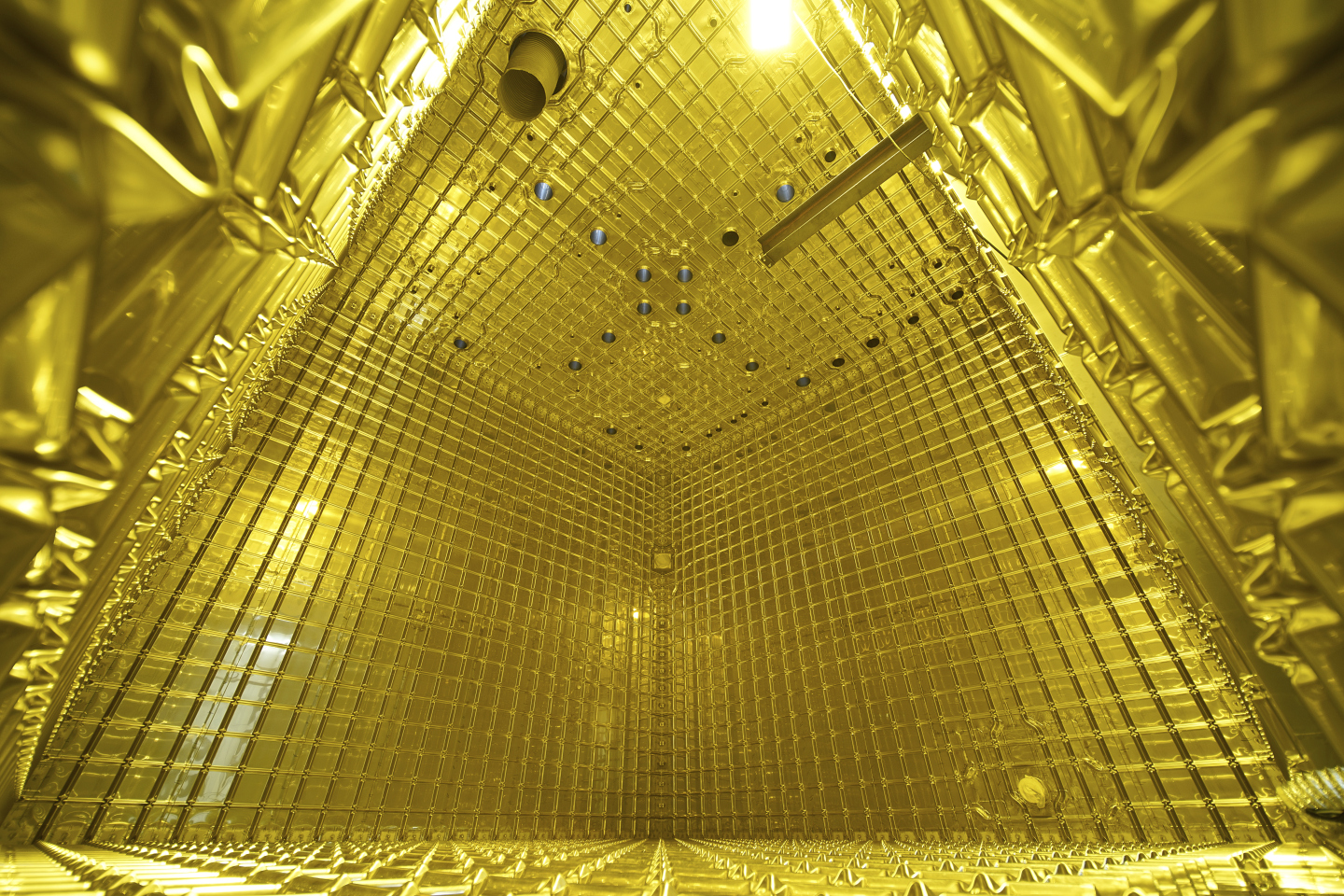
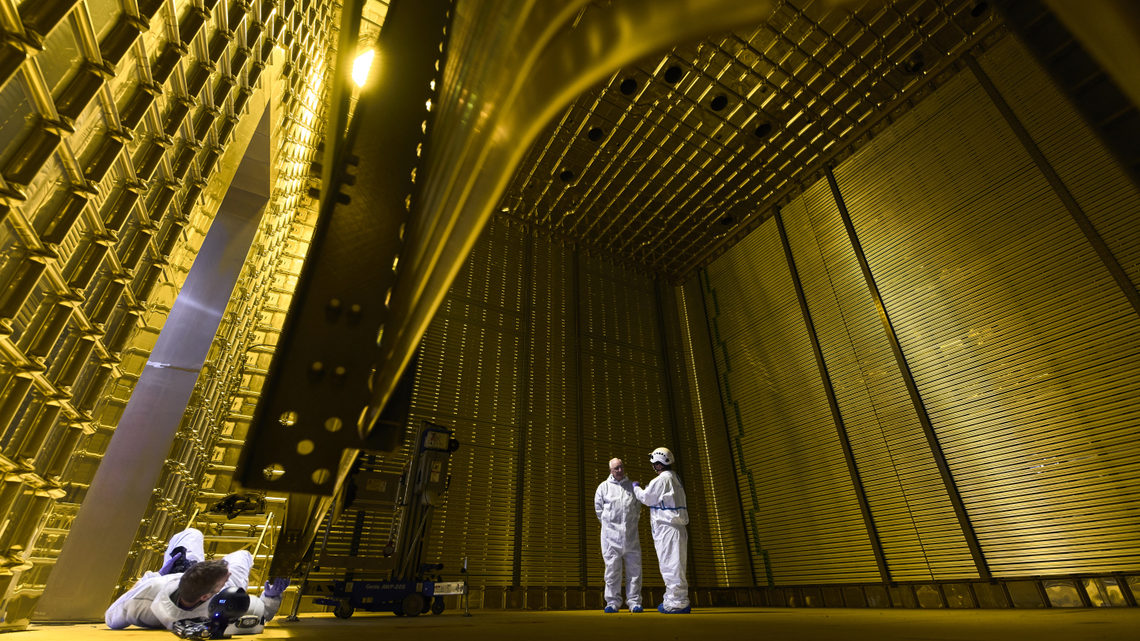
[snip]
Hints that there was something especially weird about neutrinos began to crop up in the 1970s. Physicist Raymond Davis Jr. led an experiment involving a 100,000-gallon tank filled with the dry-cleaning chemical perchloroethylene, built 4,850 feet beneath the surface at the Homestake Mine in order to shield it from particles from space. The experiment detected neutrinos from the Sun—but only around a third of how many they expected to find. Follow-up searches continued until 1998, when the Super-Kamiokande (Super-K) experiment in Japan discovered that neutrinos from the atmosphere could oscillate between flavors. In 2001, the Sudbury Neutrino Observatory in Canada discovered neutrino oscillations in solar neutrinos. In order for neutrino oscillations to make sense, neutrinos would need to have mass—contrary to the predictions of the Standard Model of particle physics, the theory that has predicted the existence of the other fundamental particles, such as the Higgs boson discovered in 2012.
“The neutrino oscillation phenomenon, implying that the neutrino has mass, is the only phenomenon beyond the Standard Model seen in the laboratory venue,” Chang Kee Jung, distinguished professor of physics and astronomy at Stony Brook University, told Gizmodo. Particle physicists are always looking for holes in the Standard Model to explain the unexplained pieces of our universe, such as dark matter. Neutrinos having mass when the Standard Model predicts that they wouldn’t could therefore be an inroad toward solving some of these mysteries.
[snip]
The Particle Physics Project Prioritization Panel advisory board highlighted the importance of a long-distance neutrino experiment in their 2014 report, and the Long Baseline Neutrino Experiment soon turned into an international collaboration based at Fermilab. That collaboration became the Deep Underground Neutrino Experiment (DUNE), now referred to as LBNF/DUNE (LBNF for the Long Baseline Neutrino Facility).
The pre-excavation phase has already begun to prepare the mine for such a massive project. Ultimately, they’ll excavate a mass of rock weighing more than two Empire State Buildings, which they’ll need to bring up a shaft and put along a conveyor belt in order to dump it into a former mining area. They’ll also need to upgrade the former mine’s ventilation system and infrastructure so that at least 144 people (or more) can fit in the lab at the same time, Jaret Heise, science liaison director at the Sanford Underground Research Facility in the former Homestake Mine told Gizmodo.
Aiming for groundbreaking discoveries:
Origin of Matter
Could neutrinos be the reason that the universe is made of matter rather than antimatter? By exploring the phenomenon of neutrino oscillations, DUNE seeks to revolutionize our understanding of neutrinos and their role in the universe.
Unification of Forces
With the world’s largest cryogenic particle detector located deep underground, DUNE can search for signs of proton decay. This could reveal a relation between the stability of matter and the Grand Unification of forces, moving us closer to realizing Einstein’s dream.
Black Hole Formation
DUNE’s observation of thousands of neutrinos from a core-collapse supernova in the Milky Way would allow us to peer inside a newly-formed neutron star and potentially witness the birth of a black hole.
How will PIP-II take Fermilab to the next level?
What is the DUNE experiment?

19 May 2020
https://gizmodo.com/why-the-u-s-is-betting-it-all-on-the-most-puzzling-par-1843517654
Nearly 14 billion years ago, a universe appeared in an unthinkably high-energy blast. Particles started to materialize out of that energy, as did their antiparticles, which are kind of like evil twins, a mirror image with the opposite electric charge. Each and every particle had an antiparticle, scientists believe, and they would annihilate each other in a pop of energy. Most particles met their end at the hands of their antiparticle in those earliest days.
Most particles met their end, I said—but not all. A small amount of matter persisted over the antimatter, and it condensed into galaxies, stars, planets, and eventually people. Some of those people wondered: What could possibly have been different between the matter and antimatter such that the matter dominated? Or, in short: Why are we here?
Today, many physicists think they’ve identified a signpost guiding them toward that question’s answer, thanks to the strange behavior of the universe’s most abundant matter particle, the neutrino, sometimes called a “ghost particle.” The difficult-to-detect neutrino seems to undergo a strange identity-flipping process, and if this reaction occurs differently between neutrinos and antineutrinos, then this process, called neutrino oscillation, could help physicists explain why matter dominates over antimatter. Unlike the last few decades of successful particle hunts, neutrino physics is a trek into the unknown, one that the United States physics community has chosen to pursue full-on. A flagship, $2 billion experiment called LBNF/DUNE will lead the search, in pursuit of answers that may take decades or more to find.
“I think we’re seeing a real change here in what particle physics is about,” Joe Lykken, Fermilab’s deputy director of research, told Gizmodo. “For a long time, it was about producing new particles, which people won Nobel prizes for. That was fine, but at the end of the day, our job as scientists is to understand the basic processes of the universe and how it works… It’s not about adding more particles to a long list of particles; it’s about, how does the universe really operate in a fundamental way to produce what we see today?”
[snip]
Standing on the platform overlooking ProtoDUNE with CERN physicist Stefania Bordoni, I realized that these enormous cubes were just a fraction of the final DUNE far detector, the larger of the experiment’s two detectors. They were prototypes to ensure that the production equipment would work and to test two different kinds of detecting technologies. The DUNE far detector will ultimately dwarf ProtoDUNE, with its 68,000 tons of liquid argon in four units built 4,850 feet underground in the Sanford Underground Research Facility, located at the retired Homestake precious metal mine in Lead, South Dakota.

ProtoDune interior:



[snip]
Hints that there was something especially weird about neutrinos began to crop up in the 1970s. Physicist Raymond Davis Jr. led an experiment involving a 100,000-gallon tank filled with the dry-cleaning chemical perchloroethylene, built 4,850 feet beneath the surface at the Homestake Mine in order to shield it from particles from space. The experiment detected neutrinos from the Sun—but only around a third of how many they expected to find. Follow-up searches continued until 1998, when the Super-Kamiokande (Super-K) experiment in Japan discovered that neutrinos from the atmosphere could oscillate between flavors. In 2001, the Sudbury Neutrino Observatory in Canada discovered neutrino oscillations in solar neutrinos. In order for neutrino oscillations to make sense, neutrinos would need to have mass—contrary to the predictions of the Standard Model of particle physics, the theory that has predicted the existence of the other fundamental particles, such as the Higgs boson discovered in 2012.
“The neutrino oscillation phenomenon, implying that the neutrino has mass, is the only phenomenon beyond the Standard Model seen in the laboratory venue,” Chang Kee Jung, distinguished professor of physics and astronomy at Stony Brook University, told Gizmodo. Particle physicists are always looking for holes in the Standard Model to explain the unexplained pieces of our universe, such as dark matter. Neutrinos having mass when the Standard Model predicts that they wouldn’t could therefore be an inroad toward solving some of these mysteries.
[snip]
The Particle Physics Project Prioritization Panel advisory board highlighted the importance of a long-distance neutrino experiment in their 2014 report, and the Long Baseline Neutrino Experiment soon turned into an international collaboration based at Fermilab. That collaboration became the Deep Underground Neutrino Experiment (DUNE), now referred to as LBNF/DUNE (LBNF for the Long Baseline Neutrino Facility).
The pre-excavation phase has already begun to prepare the mine for such a massive project. Ultimately, they’ll excavate a mass of rock weighing more than two Empire State Buildings, which they’ll need to bring up a shaft and put along a conveyor belt in order to dump it into a former mining area. They’ll also need to upgrade the former mine’s ventilation system and infrastructure so that at least 144 people (or more) can fit in the lab at the same time, Jaret Heise, science liaison director at the Sanford Underground Research Facility in the former Homestake Mine told Gizmodo.
Aiming for groundbreaking discoveries:
Origin of Matter
Could neutrinos be the reason that the universe is made of matter rather than antimatter? By exploring the phenomenon of neutrino oscillations, DUNE seeks to revolutionize our understanding of neutrinos and their role in the universe.
Unification of Forces
With the world’s largest cryogenic particle detector located deep underground, DUNE can search for signs of proton decay. This could reveal a relation between the stability of matter and the Grand Unification of forces, moving us closer to realizing Einstein’s dream.
Black Hole Formation
DUNE’s observation of thousands of neutrinos from a core-collapse supernova in the Milky Way would allow us to peer inside a newly-formed neutron star and potentially witness the birth of a black hole.
How will PIP-II take Fermilab to the next level?
What is the DUNE experiment?






